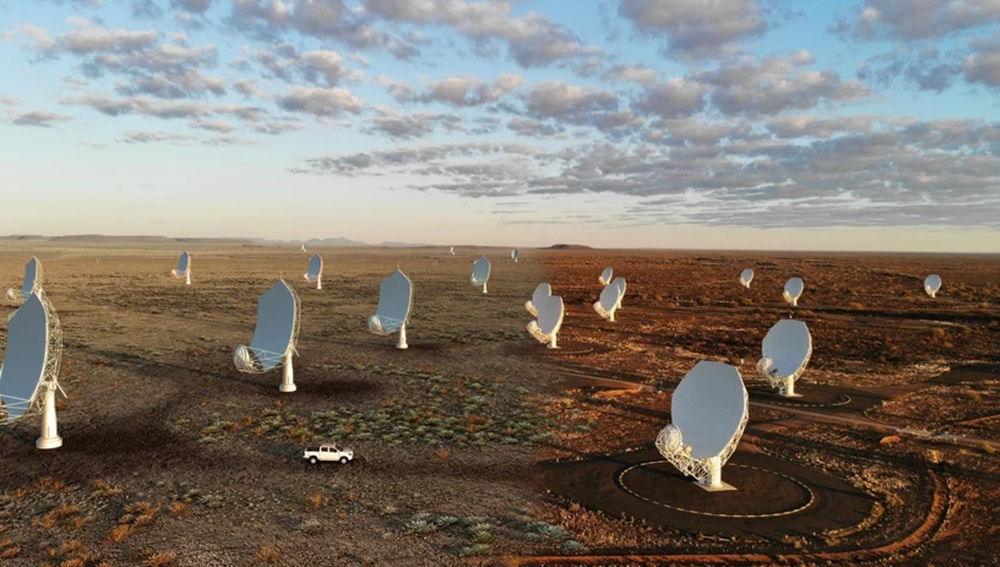Preparations for the largest radio telescope in the world
Astronomers simulate physical processes in the interstellar medium of galaxies at "cosmic noon" for future SKAO observations / Preparations for the largest radio telescope in the world

Preparations for the largest radio telescope in the world / An international team of researchers has demonstrated that the Square Kilometer Array Observatory (SKAO) is able to detect radio emissions from normal spiral galaxies in the early Universe.
The SKAO, construction of which began this year, will soon be the largest radio telescope in the world. The astronomers, part of the SKAO Extragalactic Continuum working group, are looking for a way to probe a cosmic era in which star-forming activity abruptly declined after an epoch known as the “Cosmic Noon.” To do this, they simulated the physical properties of the interstellar medium of galaxies resembling the Triangle Galaxy (M 33) and the Whirlpool Galaxy (M 51) at an early age of the Universe. The results indicate that potential surveys should be sensitive enough to detect galaxies as early as the initial build-up phase of the SKAO.
In the course of cosmic evolution, after a more active period about 10 billion years ago, the so-called “Cosmic Noon”, the galaxies experienced a decline in star-forming activity. The transition from a golden epoch of star formation to a slower rate of star formation is still not fully understood. A decrease in the amount of cool gas in galaxies, which fuels star formation, is often thought to be the main reason. Observations show, however, that many galaxies still had gas reserves large enough to support star formation.
“Another possibility is that the pressure from magnetic fields, high-energy particles and turbulence increasingly stabilized the cool gas in galaxies,” says Fatemeh Tabatabaei. She is a former researcher at the Max Planck Institute for Astronomy (MPIA) in Heidelberg and co-author of the study. Now she is a faculty member at the Institute for Research in Fundamental Sciences (IPM) in Tehran, Iran. “To understand the importance of these factors, studies of the energy balance as a function of redshift are required,” she continues.
The phenomenon that the spectra, e.g. B. emitted by galaxies are shifted to longer wavelengths over time due to the expansion of the universe. The redshift can be directly converted to a distance or age since the big bang.
To assess whether the future Square Kilometer Array Observatory (SKAO) can help solve this mystery, the astronomers simulated the physical processes in the interstellar medium (ISM) of galaxies at different redshifts. The ISM consists mostly of gas and microscopic particles, which astronomers call dust, with varying temperatures that permeate the space between the stars. The first part of this research is published today in the journal Monthly Notices of the Royal Astronomical Society.
Observing radio emission is a powerful tool to follow energetic processes in galaxies. This emission is mainly due to the interaction of high-energy particles with magnetic fields, an energetic component of the ISM. Deep and spatially resolved observations at different radio frequencies with SKAO allow astronomers to map these processes in nearby and distant galaxies. “Such observations are the crucial step in understanding the energy balance and structure formation in galaxies over cosmic time and shed light on the processes that determine galaxy evolution and the decline in star-forming activity,” explains Eva Schinnerer, scientist at MPIA and co-author of this study .
“Selecting the galaxy types and cosmic distances required to study these processes is an essential part of preparing for the actual SKAO data,” explains Mark Sargent of the International Space Science Institute in Bern, Switzerland, co-author of the study and formerly Scientists at the MPIA.
“In a first step, we wanted to simulate the radio continuum emission from the ISM of typical high redshift galaxies, using normal contemporary spiral galaxies such as M 51, NGC 6946 and M 33 as templates. Our simulation takes into account two different radiation mechanisms, thermal bremsstrahlung and non-thermal synchrotron radiation,” says Masoumeh Ghasemi-Nodehi, postdoc at the IPM and first author of the research work. “We have shown that the SKAO Phase 1 MID radio survey (SKA1-MID) can map synchrotron radiation in M 51-like galaxies down to redshift 3, when the Universe was only 1/7 its current age,” continues she continued.
“We expect that both the relativistic particles and the magnetic fields generated higher pressure in the interstellar medium at earlier times due to the higher star-forming activity in these early galaxies. This assumption, which emerges from our studies, needs to be further confirmed by the SKAO observations,” explains Fatemeh Tabatabaei.
Thanks to the sensitivity and survey speed of the SKAO, this observatory will shed light on important topics in astronomy and astrophysics. His goals include studying the formation of structures in the early Universe, the formation of the first stars and galaxies, and the evolution of galaxies. In most cases, these phenomena are studied using multi-wavelength surveys covering different parts of the sky at different stages of development.
Additional Information
This study is the result of an international collaboration, the members of which are: M. GhasemiNodehi (Institute for Research in Fundamental Sciences, Tehran, Iran [IPM]), Fatemeh S. Tabatabaei (IPM, Instituto de Astrofísica de Canarias, Tenerife, Spain [IAC ], and Max Planck Institute for Astronomy, Heidelberg, Germany [MPIA]), Mark Sargent (International Space Science Institute, Bern, Switzerland [ISSI] and University of Sussex, Brighton, UK), Eric J. Murphy (National Radio Astronomy Observatory, Charlottesville, USA), Habib Khosroshahi (IPM), Rob Beswick (Jodrell BankCentre for Astrophysics/e-MERLIN, The University of Manchester, UK), Anna Bonaldi (SKA Organisation, Jodrell Bank, Macclesfield, UK) , and Eva Schinnerer (MPIA).
Nasa boss warns of Chinese moon plans
Search For Asteroids:NASA will mothball oldie telescope / Breaking News


